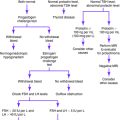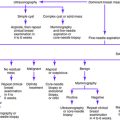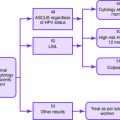Chapter 22 INFERTILITY
Infertility affects one couple in six and becomes more common as people age. Clinical evaluation of infertility is indicated if a pregnancy has not occurred after 1 year of regular unprotected intercourse. An infertility work-up should also be initiated in female patients who complain of infertility and have any of the following abnormalities: irregular menses or amenorrhea, bleeding between periods, dyspareunia, history of upper genital tract infection, history of a ruptured appendix or other abdominal surgery, or age older than 35 years.
In approximately 5% to 10% of infertile couples who proceed through a complete infertility evaluation, no cause is identified; these couples are said to have unexplained infertility. Infertility clinics may perform additional specialized testing, such as ultrasonography, testing for antisperm antibodies, and sperm function assays. Empirical treatment regimens have been designed to treat subtle disorders that may not be diagnosed.
Key Historical Features
✓ Timing of sexual intercourse
✓ Determination of whether the woman is currently having regular, monthly menstrual cycles
✓ Reproductive history, especially previous pregnancies with the same male partner
✓ Medical history, especially thyroid disorders and diabetes mellitus
✓ Surgical history, especially appendectomy or other abdominal surgery
✓ Gynecologic history, especially sexually transmitted diseases, pelvic inflammatory disease, uterine fibroids, pelvic irradiation, or previous use of an intrauterine device
✓ Medications, especially oral contraceptives
Suggested Work-Up
| Semen analysis | To evaluate for a cause of infertility in the male partner |
| Hysterosalpingography | To evaluate the uterine cavity and determine whether the fallopian tubes are patent |
| Thyroid-stimulating hormone | To evaluate for thyroid disorders |
| Prolactin measurement | To evaluate for hyperprolactinemia |
| Measurement of estradiol and follicle-simulating hormone (FSH) level on cycle day 3 | For patients aged 35 years and older to help determine ovarian reserve |
| Elevated basal FSH levels higher than 8 to 10 mIU/mL are suggestive of declining fertility potential, and a concentration higher than 20 mIU/mL virtually excludes the chance of a spontaneous pregnancy | |
| Measurement of serum progesterone on cycle day 21 | A level above 10 ng/mL confirms that ovulation has occurred |
Additional Work-Up
| Basal body temperature measurement | May be used to help predict the timing of ovulation, but no longer recommended as part of the routine investigation of an infertile couple |
| Clomiphene citrate challenge test | May be used to increase the sensitivity of a basal FSH determination |
| The FSH level is measured both before and after the administration of 100 mg of clomiphene citrate during days 5 through 9 of the menstrual cycle | |
| Elevation in the serum FSH level after the clomiphene citrate challenge indicates decreased ovarian reserve | |
| Total testosterone and dehydroepiandrosterone sulfate levels | If signs of androgen excess are found on physical examination |
| Laparoscopy | Generally indicated in women with otherwise unexplained infertility and when there is evidence or suspicion of endometriosis, intrapelvic adhesions, or fallopian tube disease, particularly if the hysterosalpingogram is suggestive of tubal disease that may be amenable to surgical repair |
| Measurement of serum antibody to Chlamydia trachomatis | May be used as a screening tool for tubal pathologic conditions in infertile women |
| Routine cervical cultures | To identify active current chlamydia or gonorrhea infection in low-risk populations |
| Postcoital test | Indirectly measures cervical mucus competency |
| Not routinely performed as part of the basic infertility evaluation because of marked variability in performance and variable interpretation | |
| Endometrial biopsy | Provides an indirect measure of ovulation and evaluates the cumulative effect of progesterone on the endometrium; however, there is little role for routine endometrial biopsy as part of a general infertility evaluation |
| Sonohysterography | May be used as an alternative to hysterosalpingography to evaluate the uterine cavity but provides little information about the patency of the fallopian tubes |
| Magnetic resonance imaging | May be helpful in visualizing the uterine cavity and determining tubal patency |
Brugh VM, Nudell DM, Lipshultz LI. What the urologist should know about the female infertility evaluation. Urol Clin North Am. 2002;29:983-992.
Hargreave TB, Mills JA. Investigating and managing infertility in general practice. BMJ. 1998;316:1438-1441.
Illions EH, Valley MT, Kaunitz AM. Infertility: a clinical guide for the internist. Med Clin North Am. 1998;82:271-295.
Penzias AS. Infertility: contemporary office-based evaluation and treatment. Obstet Gynecol Clin. 2000;27:473-486.
Smith S, Pfeifer SM, Collins JA. Diagnosis and management of female infertility. JAMA. 2003;290:1767-1770.
Taylor A. ABC of subfertility: extent of the problem. BMJ. 2003;327:434-436.





